





Since October is Mutants and Monsters month, I find it appropriate to discuss some of favorite monsters- the monstrose and cristate plants. Monsters and Crests occur in many plants, but seem to be particularly common and collectible in Succulents and Cacti. This article serves as an introduction to these bizarre oddities.
Succulents (including cacti) are among the best of all the plants to collect and grow in pots and in the garden and are certainly among my favorite plants. As if there weren't enough awesome, cool and bizarre succulents in cultivation to keep one fascinated and obsessed for a few lifetimes, these amazing plants also have their mutant forms- the crested and monstrose plants. Crested or monstrose mutations are not unique to succulents, but they certainly seem to be much more common in these plants than they are in most other flowering plants and conifers.
What happens when a plant mutates like this?
All plants have a growth center (or growth centers depending on how many branches, leaves, flowers etc. they have). On most succulents that have been found to crest, this apical meristem is where the primary growth of the plant occurs and normally these primary growth centers produce cells from a single point and as new cells are formed all the older cells are moved outward in a nearly radially symmetrical pattern (creating columns or branches that tend to be circular in cross section).
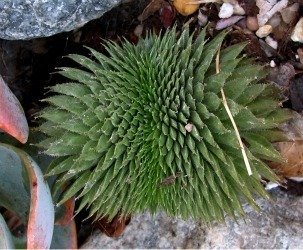
This Sempervivum was one of hundreds I have struggled to grow in the garden over the years (most are pretty wimpy in this climate). But for some unknown reason, this particular plant began to crest. You can almost see the linear plane of tissue growing out each side, when it SHOULD be growing from a central location radially.
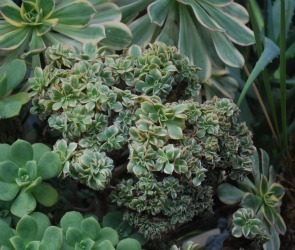
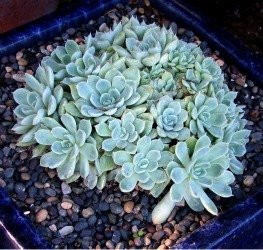
These two plants also spontaneously crested in my garden, though the crested areas are harder to see since they are producing lots of dinky leaves (relatvie to the normal leaves). Aeonium 'Sunburst' (a variegate- another mutation seen frequently in succulents) on the left and Echeveria elegans on the right.
But when a mutation occurs in this apical meristem, often a linear row of meristematic cells develop creating a growth pattern that originates from a line rather than a single point. This mutation is what causes cresting (aka fasciation) to occur and flattened planes of new growth to develop. Instead of forming perfectly flat sheets of tissue more often curling develops as a result of external and natural internal forces. This results in the formation of ornamental waves or walls of new growth that can develop into a wide variety of interesting shapes and patterns (in cacti, many form 'brain-like' structures). Crested plants often look very different than their normal counterparts, but usually there is some recognizable tissue and/or coloration, and often normal growth areas grow out of the same plant alongside the crested areas. Crested plants can develop their mutation early in life but more often a crest develops later on, so a normal looking plant will develop a crested section. Plants that crest early in life tend to stay somewhat immature and rarely flower or develop a reproductive functional anatomy. Those that creat later can usually flower and reproduce normally.
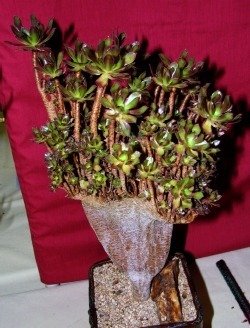
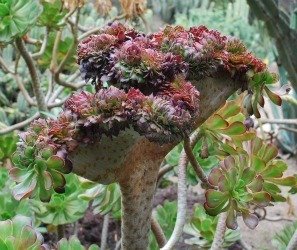
Here are two Aeonium arboreum 'Atropurpureum' crests. It looks like the one on the left crested earlier in life (though this could be a rooted cutting) since the lowest portion of stem is flattened (when it should be cylindrical)... but the top almost looks like it's 'defasciating' or reverting. Right plant is a mature individual that developed a crest mutation on one of its branches. These two crested individuals show a flattened plane of growth
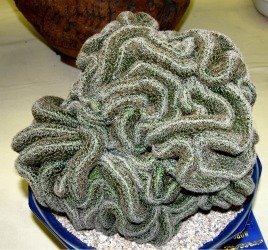
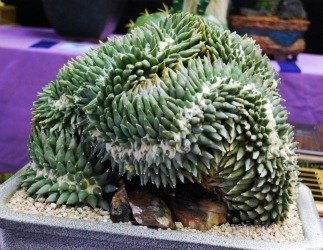
These two cacti, on the other hand, show more typical undulation and curving that occurs as crests continue to develop and mature. The Parodia densispina on the left is showing the typical 'brain'-like appearance of many cactus crests. The Ariocarpus retusa on the right resembles a tidal sea creature thanks to its gorgeous undulations mixed with its more typical tubercular shape. Both these cacti retain some of the plant's original coloration and spination (or lack thereof), but do not really look anything like the normal plants.
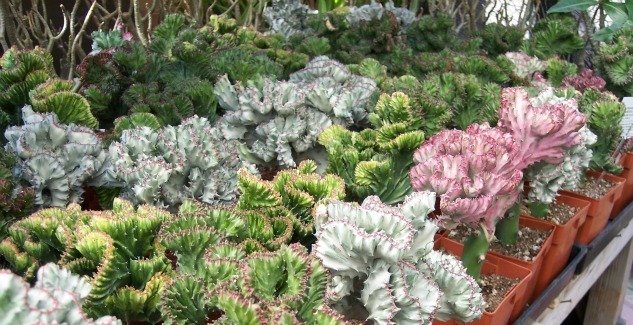
These Euphorbia lactea crests show the more typical fan-like undulation seen in most cristate Euphorbia species. Some might notice this is the same photo in the other mutant plant article of the month- the one on variegated plants, as many of these crested Euphorbias also show varying degrees of variegation as well. Notice these plants are all grafted on a different Euphorbia species- one with a healthy root stock and probably one much more able to photosynthesize and deal with more irregular watering schedules.
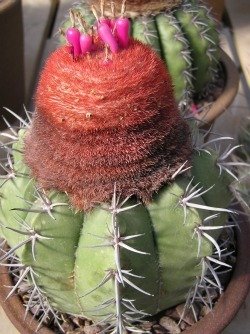
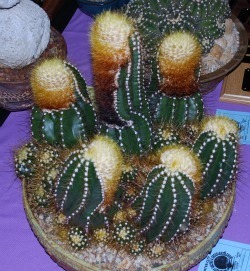
These two cacti are NOT crested, though many think these are crested plants. These are two of many species of cacti that develop special areas, either on the top (as in the Melocactus species on the left) or, more commonly, along the top and down one side (like the Coleocephalocereus aureus cacti in the right photo) called cephalums. Cephalums are not mutations, however, and are a genetically consistent structure these species form with age and where the flower parts arise from.
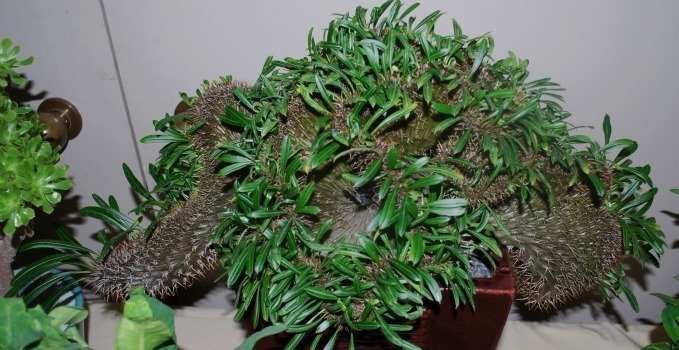
Pachypodium lamerei crests are fairly common mutations, but they eventually outgrow themselves and collapse
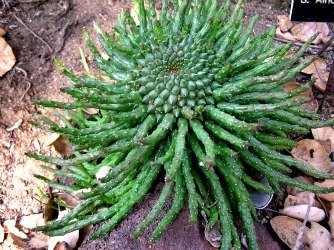
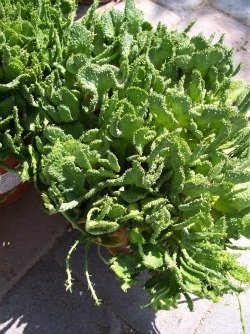
Crests to do not always form in the same tissues, and where they form will create a different look even in the same species. Left is a normal form of Euphorbia flanaganii, a medusoid Euphorbia frequently found to crest. Right is a very common crested form of this species in which the 'arms' of the medusa have all (or almost all... you can see a few normal arms at the bottom of the photo and mixed in here and there) crested. This form of cresting is so common that these crested Euphorbia flanaganiis are frequently encountered at garden outlet shops.
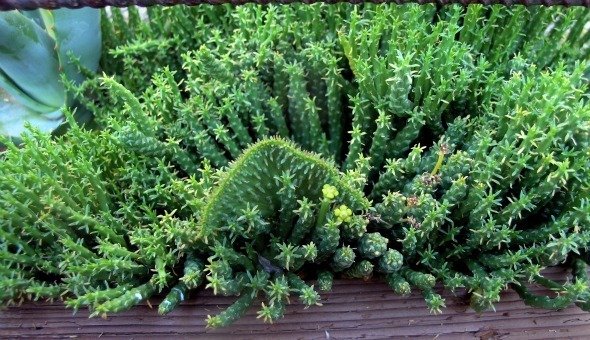
This specimen above was one I planted in my yard. It was completely normal at the time, but grew rapidly thanks to my overwatering and the very rich, fertile soil. And sure enough, a crest formed in my plant.
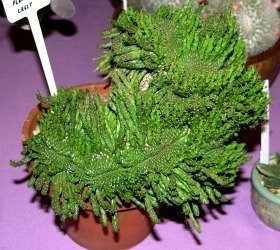
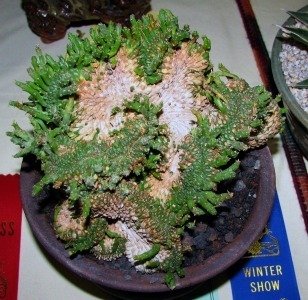
The Euphorbia flanaganii on the left has a cristate mutation in the tissue that forms at the top of the stem from which the 'arms' arise. Therefore this plant has a linear, curving ridge of crested basal tissue but normal looking arms (sort of... most of the arms are a bit stunted and irregular). The much rarer form of Euphorbia flanaganii crest on the right is showing a cristate or fasciate mutation of the central stem of the medusoid structure and only somewhat involving the basal 'green' tissues.
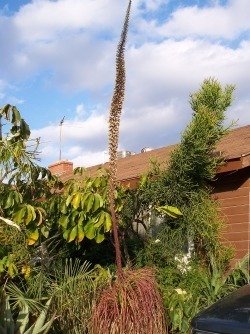
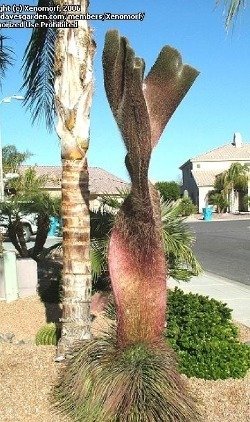
One of the more spectacular crested plants I have seen photos of is this amazing Agave geminiflora crest of a flower stalk on the right (photo by Xenomorf); a normal flowering plant is shown in the lefthand photo. I think this is the only cristate flower stalk I have seen in a succulent species.
When mutations occur in a more systemic fashion (rather than at a single growth point) involving all the meristematic tissue in a plant, the result is what is known as a monstrose pattern of growth. In these plants all or most of the growing points start to develop haphazardly (sort of like how cancerous tumor grows in our bodies) and the result is a lot of knobs, bumps, asymmetrical and shortened limbs, branches or columns and generally a weird, stunted and freakish overall appearance. These monstrose plants are often so different from the unaffected plants that the two do not look related. In my limited experience, most monstrose plants rarely have normal plant parts growing alongside the weird ones, but it does happen now and then. Monstrose plants tend to develop their mutation early on rather than later in life.
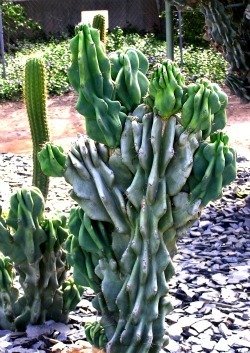
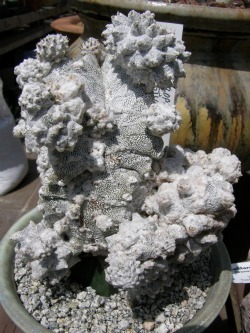
left is a crested form of Astrophytum myriostigma, a commonly grown spineless cactus available at most succulent nurseries. The crested plants are quite rare however (photo cactus_lover); on the right is a Monstrose form of this same species. So instead of the plant growing along a linear plane, now numerous areas of abnormal mutant growth occur all over the plant. This form has been called Astrophytum myriostigma 'Lotusland' as that is where this particular clones was propagated.

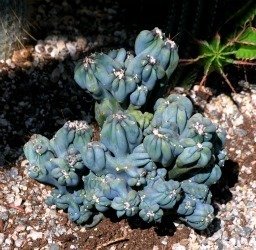
The above Cereus cacti (Cereus jamacara left and Cereus hildmannianus right) are typical monstrose looks for many cacti, but particularly the Cereus genus.
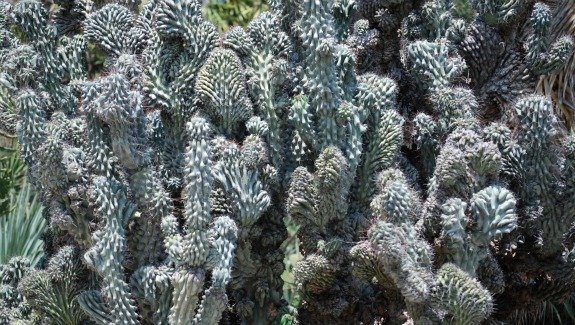
The large Cereus species growing outdoors in the Huntington Gardens is a monstrose individual that is also showing a lot of cristate mutations as well
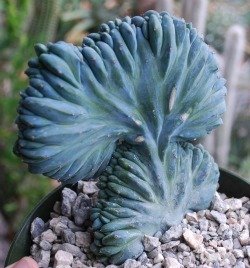
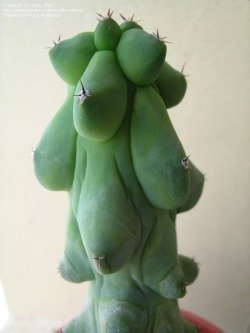
Myrtilocactus geometrizans is a very common species to see cresting (left), but pretty rare to see with a monstrose mutation (right- photo Kada)
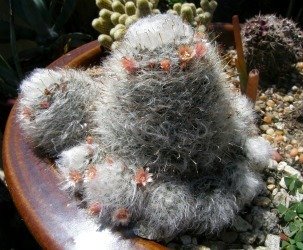
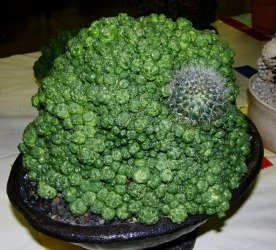
The monstrose form of Mammillaria bocasana (normal form in left photo) is so unlike its normal version that for years these monstrose mutations were thought to be a completely different cactus species. But then some would show a bit of a reversion (defasciation) as seen in the plant on the right. This monstrose Mammillaria bocasana has been sold and grown in the nursery field as Mammillaria 'Fred'. It is one of the more popular and sought-after monstrose cacti
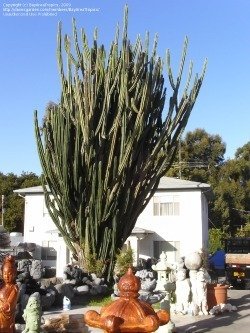
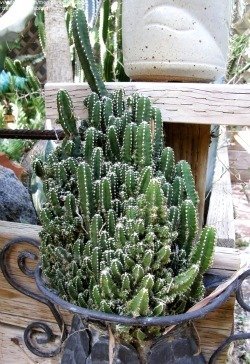
Both the giant, 20-foot-tall cactus on the left (Cereus hildmannianus subsp. uraguayanus- photo BayAreaTropics) and the 12-inch-tall mature plant on the right are the same subspecies of cactus. Only the plant on the right is a monstrose version of the monster on the left called 'Fairy Castle', and is a very popular and commonly available monstrose cactus in cultivation.
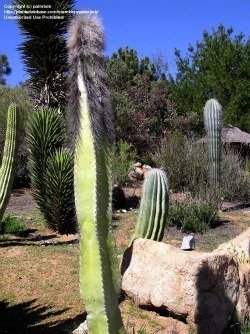
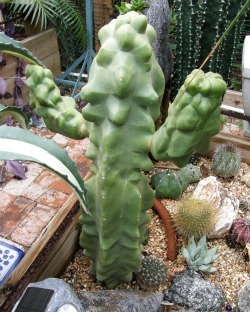
Pachycereus (aka Lophocereus) schottii is an example of a monstrose mutation seen in several other species of cacti in which the plants have lost some to all their spines and all the edges are more rounded. These monstrose forms are so common and popular that finding the original form (left photo) are so rare, some think that all Pachycereus schottii are lumpy, spineless plants. There are two distinct forms of this monstrose cactus- a fat one and a skinny one. This plant on the right in my yard is one of the fatter ones. These are excellent landscaping and potted plants- very hardy and easy to grow (from cuttings, too) and other than their relatively shorter stature and much slower growth, are excellently adapted plants to a variety of enviroments.
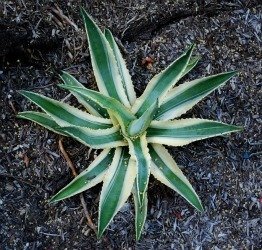
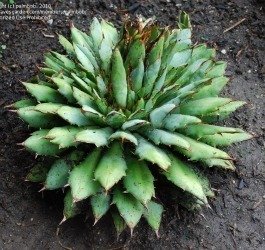
In Agaves, the monstrose mutation takes on a completely different look, basically stunting and somewhat deforming leaves, but not making the plant look all that different from its original shape and color. Agave 'Cornelius' on the left is a monstrose form of Agave americana variegata and grows much more slowly, is much smaller and has slight twisted stunted leaves... but it is a great, hardy potted or landscape plant. Right is a rare monstrose form of Agave titanota showing stunted, somewhat fused leaves and multiple growth centers.
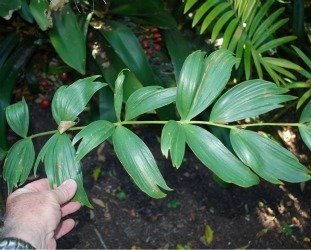
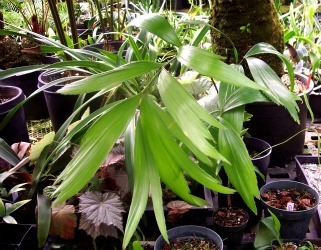
Cycad monstrose mutations are generally limited to the leaf meristem and as a result one gets repeated monstrose changes in each leaf resulting in irregularly deformed leaves, often thicker than normal and usually split rather than smooth-edged and entire. Left is Ceratozamia hildae monstrose, and right is Zamia splendens monstrose
Why does this happen?
The precise cause of these mutations is unknown. Many suppose a bacterial, fungal or viral infection may cause some genetic disturbance. Another pathogen called a phytoplasma (sort of half way between a bacteria and a virus) has been shown to be the causative agent of cresting in at least some species. Chemical and physical trauma have to be included in the list of possibilities, though usually that sort of occurence damages the meristem (growth center) in such a way that it simply begins to divide, resulting in 'ordinary' branching or multiple heads. But for some reason, sometimes the result is crestation instead. I am sure pesticides and other toxic chemicals can alter gene function and result in mutations like this as well. Perhaps radiation from the sun is another possible mutation cause. Some plants seem more prone to this mutation at various seasons, so temperature, humidity or heat may have some influence. Some nutritional deficiencies have been known to lead to cresting mutations (e.g., Zinc deficiency) as well. And sometimes mutations can occur spontaneously (no external force needed)- just a chromosomal aberration resulting from some internal error in transcription or translation.
Either way, it has been difficult to nearly impossible to artificially produce many crested or monstrose mutations in cultivation. Such mutations are rarely heritable (so seed from such plants only produce more normal plants), at least in succulents; some dicots have been shown to have a heritable fasciation gene. But there has to be some sort of genetic tendency for these mutations to occur as many species form crests fairly commonly while others have never been found to do so. It is interesting to note the most succulents and cacti that form crests are those designed for extreme environments, while those who have evolved in more humid, temperate climates rarely crest (some exceptions of course). And there are some cacti and Euphorbia species where crested individuals are so common that one can obtain them at local nurseries as cheaply as the normal plants. Some are so common that it will not be unusual to so some purchased, cultivated normal plants to start cresting spontaneously in the garden. There still is a lot of research that should be done in this field.
Do crested and monstrose plants grow slower than normal ones?
Yes and no. Initially it appears that many crested species grow faster which is not surprising as there are many more growth points. But this increased rate of tissue production seems to have its limits, and when the plant tissues begin to become crowded, they often seem to cease growth, and often even form isolated spots of ‘defasciation' (reversion to normal growth), and several columns of normal plant material will erupt from this stalled crest formation. Most growers of prized crested plants will quickly remove these areas of reversion so the plant will concentrate its efforts on keeping the crested tissues happy and alive (and cool looking).
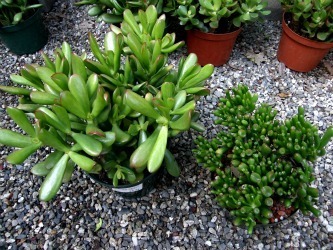
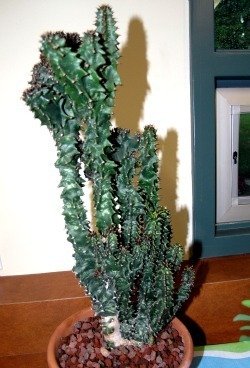
Both Crassula ovata 'Hobbit' and Crassula ovata 'Gollum' are mutations of the original species, though Crassula 'Hobbit's leaves are only slightly affected while those of 'Gollum' are truly monstrose. The two plants in the photo on the left are the same age, yet the 'Hobbit' on the far left is nearly twice the size as the 'Gollum' of the same age. Right is an old Euphorbia ingens monstrose form... about three feet tall... yet a normal Euphorbia ingens that age would probably be closer to 30 feet tall by now.
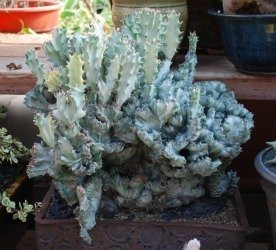
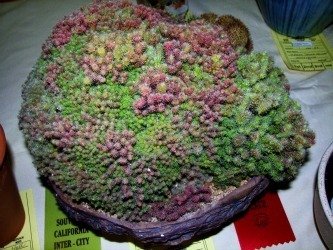
This Euphorbia lactea 'Ghost' crest (left) is showing reversion of the cristate growth back to normal, upright growth (defasciation). Most collectors would cut off all the new normal growth to keep the bizzare look intact, but this plant is sitting in the back of a nursery. Right is a weird monstrose Mammillaria that is growing some normal, defasciated tissue seen near the back right side
Monstrose plants on the other hand definitely seem to grow more slowly from day one. These plants are often stunted, though not all plants are monstrose 'all over'. Some have selected areas of monstrosity (eg. leaves only) and these plants tend to be more normal in shape and size.
Are crested and monstrose succulents more sensitive and harder to keep alive?
In general, these plants are more sensitive and touchy, which is really not surprising. Plants have evolved to grow in certain rates, shapes and sizes for a reason, and mutated plants that grow differently are very likely to be less well adapted to the original environments and may succumb. Growers of crested and monstrose plants often find they have to grow their plants a bit ‘harder' (water even less than normal) as the abnormal tissues are more likely to crack, grow too fast in spots and become injured, or simply rot, due to their physical changes from the ordinary. Fortunately plants in cultivation are not at the same ‘environmental mercy' as plants in the wild are, and probably far more crested plants survive in cultivation than in the wild (depends on the grower of course... plants under my care are really subject to abuse that even the wild could not match... as a result, I have few surviving crested or monstrose plants in my collection. Those that survive year after year are extremely tolerant, hardy plants!)
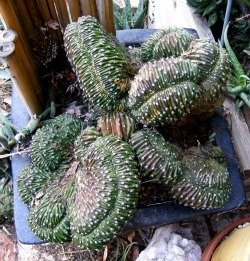
This plant (Echinopsis species?) was beautiful... until it rotted where the heavy cristate segments sat in the soil- oops.
This is one of the reasons crested succulents grown in cultivation are grafted onto other plants- often very hardy and non-fastidious species with relatively minor nutritional needs. These grafted plants rely upon their base species to absorb water and perform many of the biochemical pathways needed for proper growth that they do not perform as well. But these basal plants often continue their own struggles to not only survive, but become dominant, and healthy new growth will often branch off them. These branches need to be removed in a timely fashion or the mutational graft may suffer..
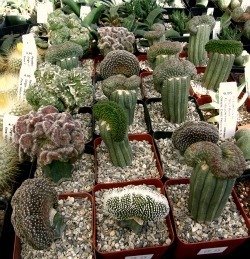
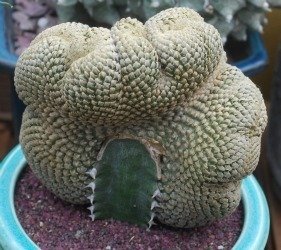
These crested cacti for sale in the left photo are all grafted plants- less like to die, and more likely to stay healthy that way; Euphorbia piscidermis crest on right hand photo grown on a Euphorbia canariensis cutting
Probably most monstrose mutations die early on, possibly so early they do not even develop far enough for one to recognize they are monstrose. So it is only the monstrose mutations that are compatible with life that we get to see grow far enough for us to recognize them and collect and marvel at them. Who knows what percentage of all monstrose mutations these survivors are?
Some crested and particularly some monstrose succulents, however, seem to be perfectly adapted and hardy, or at least not noticeably less so than their normal relatives. If the mutation does not affect the plant's ability to photosynthesize, grow upright and remain stable, and deal with water similarly, there is little reason such a mutation will affect the plant negatively. Though one wonders then why such mutations do not seem to take over in the wild and develop eventually into their own species. Perhaps, over time, they will?
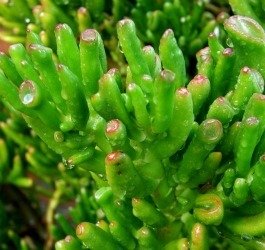
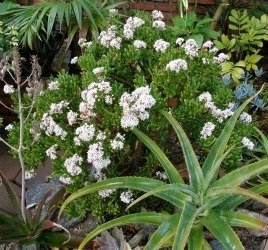
This Crassula 'Gollum' though a bit slower and shorter than the normal Crassula ovata, is as easy to grow, as hardy and flowers as well as the normal plants in my garden
Below are just some of the crested and monstrose plants I have seen (and sometimes grown) in southern California at various cactus and succulent shows, nurseries or in various botanical or private gardens.
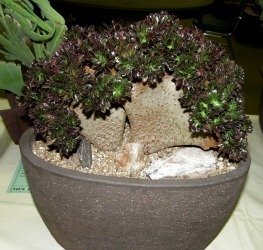
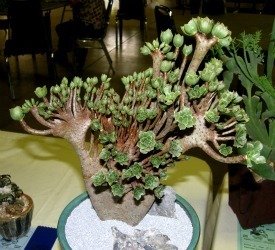
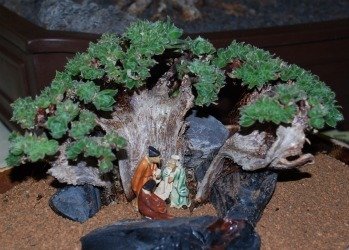 These are are show quality Aeonium cristate plant. Upper left Aeonium arboreum 'Atropurpureum', upper right was not labeled, but looks like Aeonium balsamiferum (hard to tell when crested), lower right is a rare species, Aeonium simsii.
These are are show quality Aeonium cristate plant. Upper left Aeonium arboreum 'Atropurpureum', upper right was not labeled, but looks like Aeonium balsamiferum (hard to tell when crested), lower right is a rare species, Aeonium simsii.
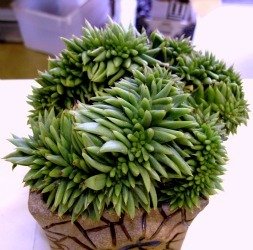
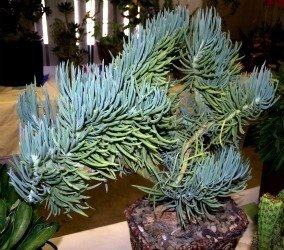
Left is a crested form of Echeveria agavoides; right is a Senecio cylindricrus crest
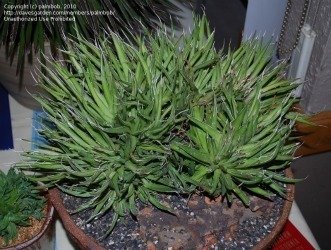 l
l 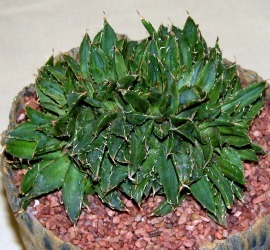
Agave filifera and Agave titanota monstrose forms, also in Los Angeles cactus shows
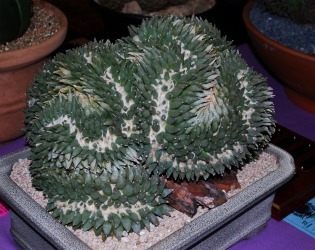
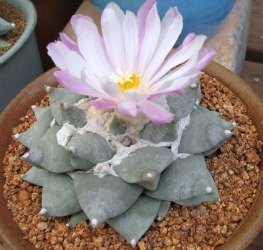
Left is a grand prize winning Ariocarpus retusa crest; right, for reference, is a normal Ariocarpus retusa plant
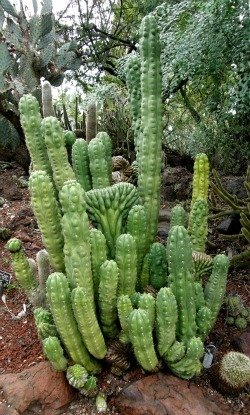
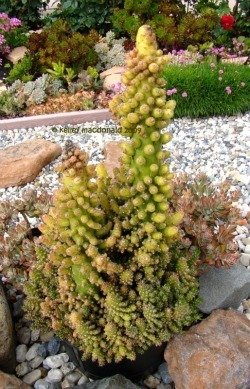
Left and below are two crested Echinopsis species (lower might be Echinopsis pachinoi); right is a monstrose Austrocylindropuntia sublata (photo by Kell)
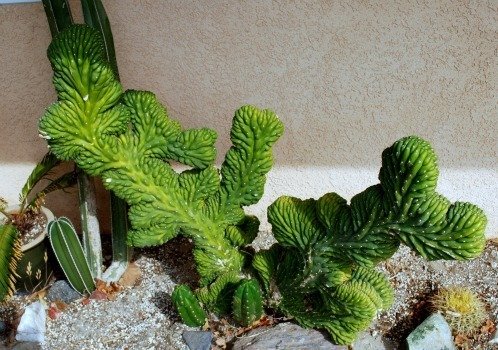 This crested plant has a few normal columns coming up in front
This crested plant has a few normal columns coming up in front
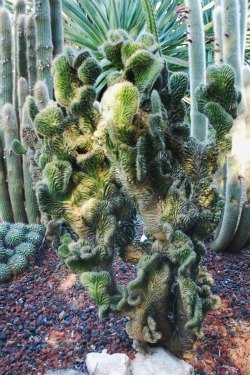
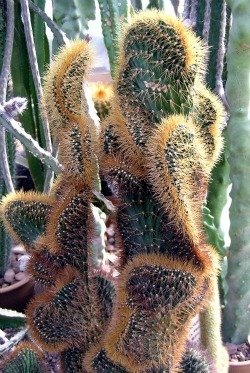
left is a crested Cereus species in Lotusland, Santa Barbara, California; right is a nice crested Cephalocereus urbanianus in the Huntington conservatory
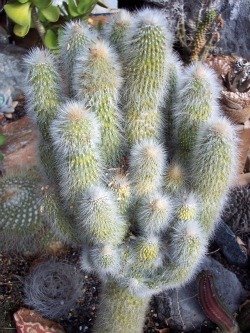
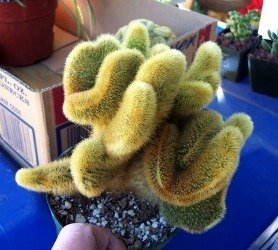
left is a monstrose version of Cleistocactus strausii and rigth is a crested Cleistocactus winterii, both in my garden
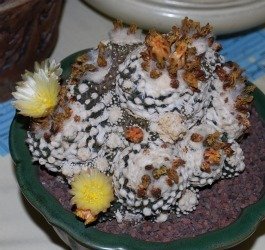
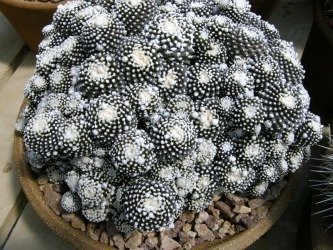
left is a normal Copiapoa tenuissima while right is a commonly encountered monstrose form of the same species
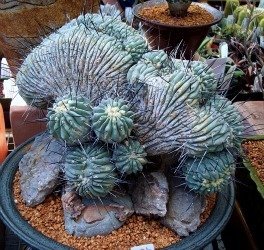
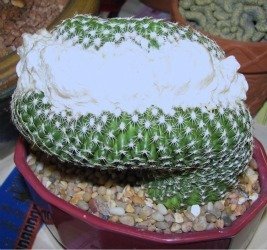
left is a crested Copiapoa cinerea for sale at a local nursery (better hurry, this a rare one!); right a crested Discocactus zehntneri
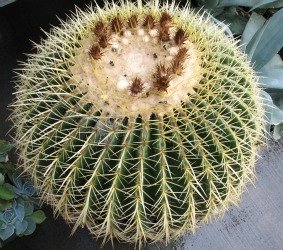
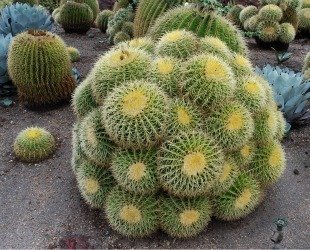
Golden Barrel Cacti (Echinocactus grusonii) are fairly common landscaping plants, and reach enormous sizes, whether as singe, massive spheres, or large clumps (right). But this is also one of the more commonly available crested species of barrel cactus (see below)
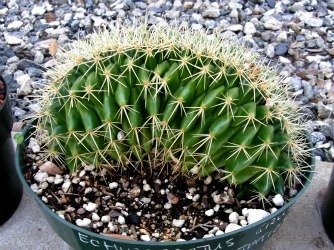
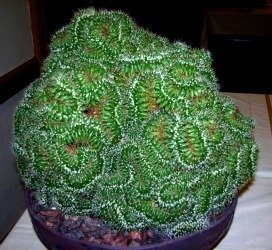
Left is a more typical crest just starting out, for sale of Echinocactus grusonii; right is a much rarer and very bizzare crested form that again resembles a brain
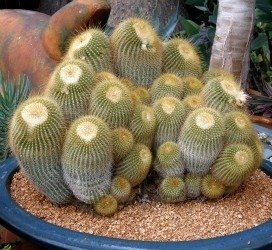
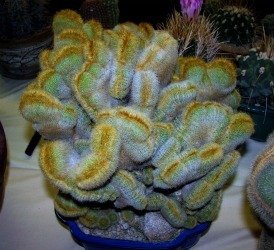
The Lemon Ball Cactus (Parodia lenninghausii) is one of the more commonly available cacti for both landscape and pot use (left), but it looks very little like its mutant, crested form on the right
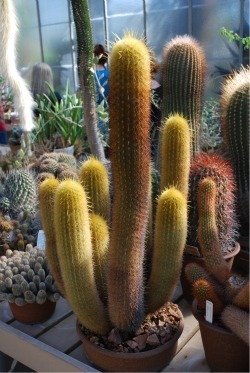
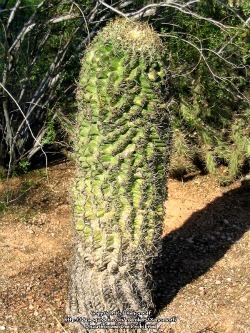
left is a normal Haageocereus pseudomelanostele cactus, and below is its monster equal, a crested plant; right is a monstrose version of Ferocactus cylindraceous (photo Xenomorf) obviously handling the stresses of nature about as well as non monstrose plants do
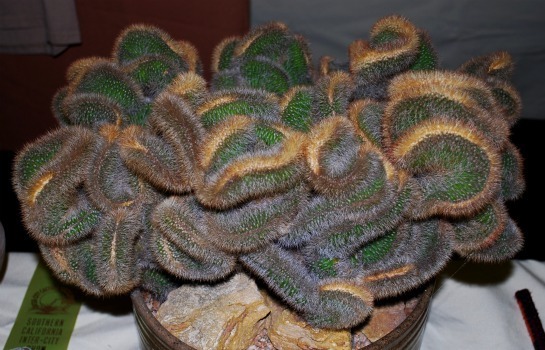 Haageocereus pseudomelanostele crest
Haageocereus pseudomelanostele crest
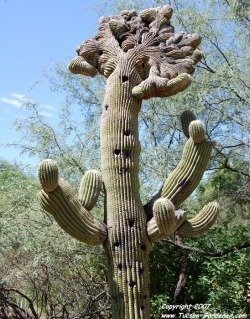
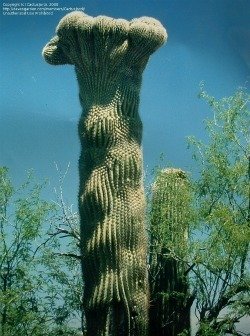
These monsters also seem to survive in nature OK. Left is a cristate Carnegiea (Saguaro Cactus)- photo Franj; and right is a monstrose version of the same species (photo CactusJordi)
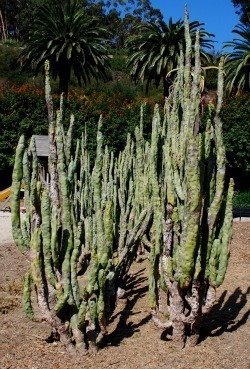
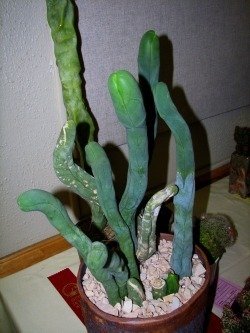
left are more of these Pachycereus schottii monstrose plants that are so popular, showing their typical gnarled, knobby, spineless shapes; right is another 'bald' form of monstrose cactus- Trichocereus (aka Echinopsis) bridgesii
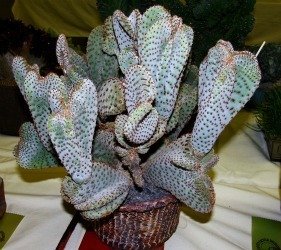
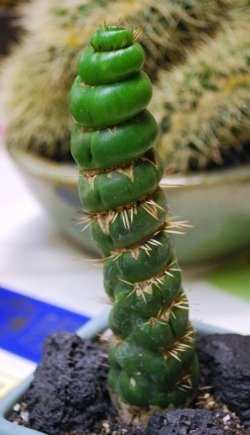
left is a monstrose Opuntia basilaris (or maybe cristate?); right is one of my favorite of all the monstrose cacti, a Eulychnia sp. which grows like a tight spiral corkscrew and is one of the most bizzare and ornamental of all the cactus monsters in my opinion.
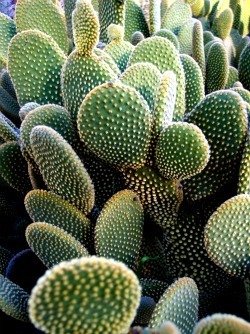
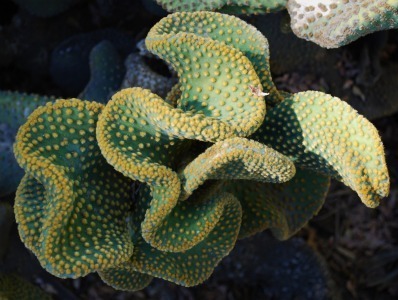
One of the most popular and well known mutant cacti is the Opuntia microdasys var. pallida monstrose form (normal form on left) called 'Funny Bunny'. This monstrose cactus I find grows very well but eventually gets too leggy and pieces fall off... though I am not sure that doesn't happen with the normal plants, too. It is a hardy mutant, however, and a good landscape plant. Some may say these are cristate, but Opuntia pads are already a fan shape, and what you see in the 'Funny Bunny' plants is bizzare and totally irregular growth patterns with folded pads, stunted shapes and all sorts of weird, irregular growth patterns, There is no real linearly bases cristate growth pattern, but its already fan-shaped pads make it look like this is a cristate mutant.
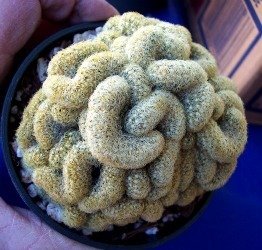
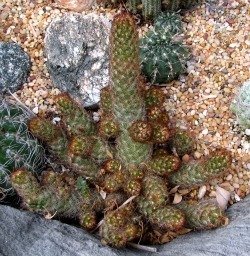
Though I have dozens and dozens more photos of cristate and monstrose cacti I could show here, I am rapidly running out of room. But no article on cristate cacti would be complete without a few shots of the original 'brain cactus', the cristate form of Mammillaria elongata (normal, though copper- colored, plant on right).
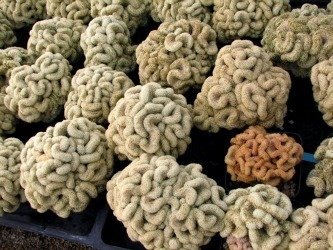
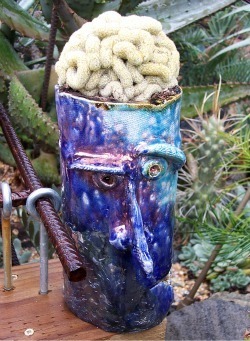
These tightly undulating globoid brains, complete with sulci, are very common cristate mutants of a pretty common garden Mammillaria. These are not particularly hard to keep alive, but they do rot easily if grown in the ground, so I put mine in a raku pot I made (right), where it has lived for years. Reportedly they reach this size fairly quickly, but then seem to simply stop growing (just continue to grow but very slowly)
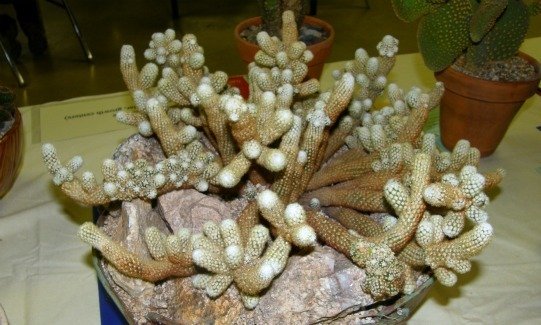
This species also comes as a nice monstrose form, which also does very well in pots and I have had one of these for years, too, in the garden
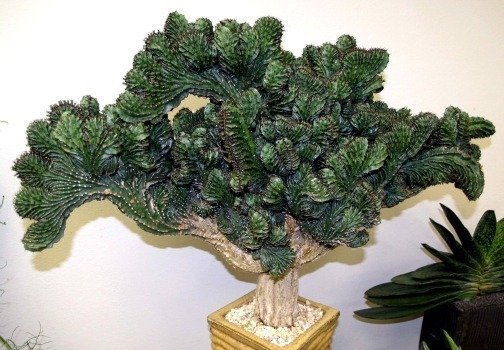
a prize winning crested Euphorbia called Euphorbia 'Garretson' (or was labeled as such)
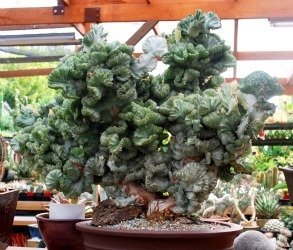
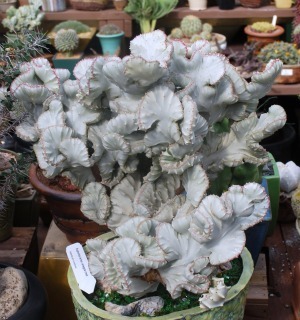
These Euphorbia lacteas are remarkably large for crests, which tend to eventually collapse on themselves. Plant on right is nearly a complete albino as well
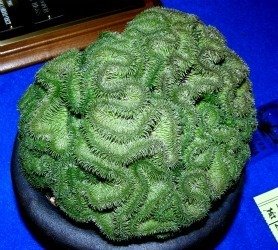
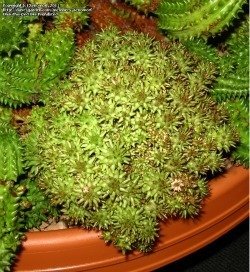
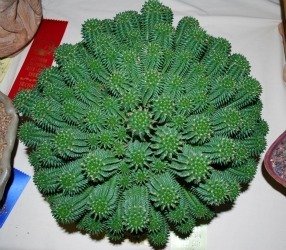 Euphorbia susannae crest upper left, monstrose upper right and normal left
Euphorbia susannae crest upper left, monstrose upper right and normal left
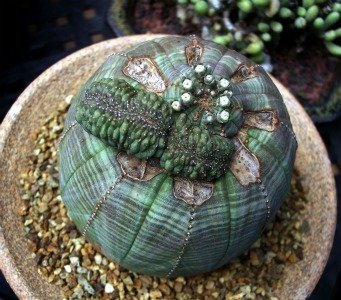
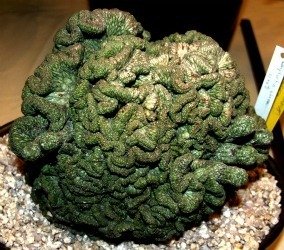
Euphorbia obesas make very interestig crests, like the plant on the left just starting to crest, the one on the right looking like a cactus 'brain' and the show winning plant at the top right of this article.
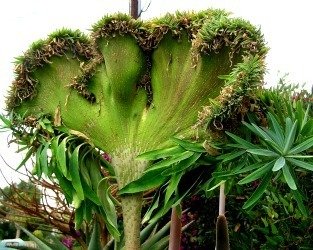
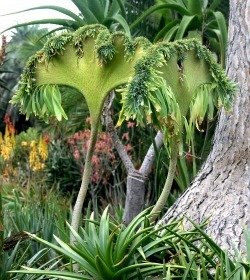
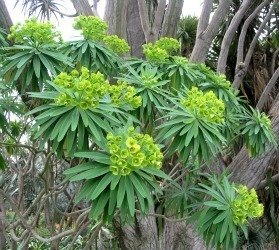 Euphorbia lambii, a common landscape tree/shrub in southern California, is one of the most commonly seen Euphorbias to crest. Just about every local botanical garden has at least one of these, and I have grown several that showed up spontaneously in my own garden (but eventually rotted). Normal looking plant lower left photo
Euphorbia lambii, a common landscape tree/shrub in southern California, is one of the most commonly seen Euphorbias to crest. Just about every local botanical garden has at least one of these, and I have grown several that showed up spontaneously in my own garden (but eventually rotted). Normal looking plant lower left photo
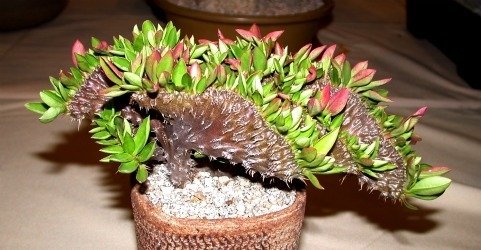
Euphorbia millii (Crown of Thorns) crest (an exceptionall one)
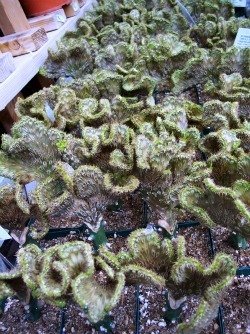
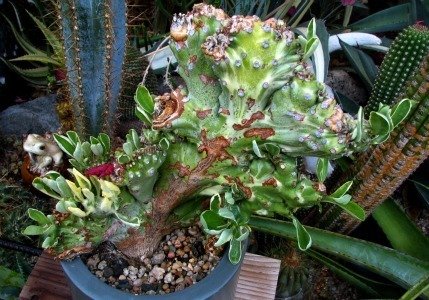
Euphorbia millii crests for sale at a nursery (left); one of the most common Euphorbias to crest is Euphorbia nerifolia. Any many of these also are variegated, as is my plant (right). These are pretty hardy plants for crests and I have had no trouble keeping this one alive for years.
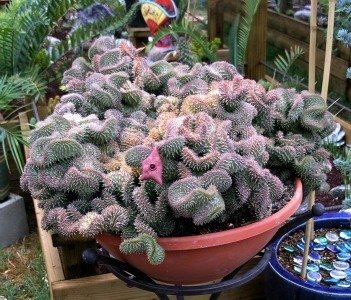
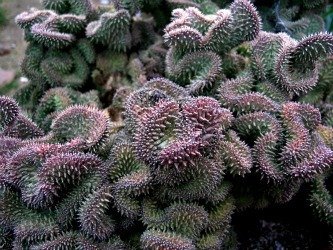
Luckhoffia beuneckeri is an Asclepid (flowers smell like rotting meat) and one of the most commonly encountered Asclepids to crest. This remarkable specimen was mine, but sadly I did not care for it well. Last only a few few years (not a good outdoor plant in my area).
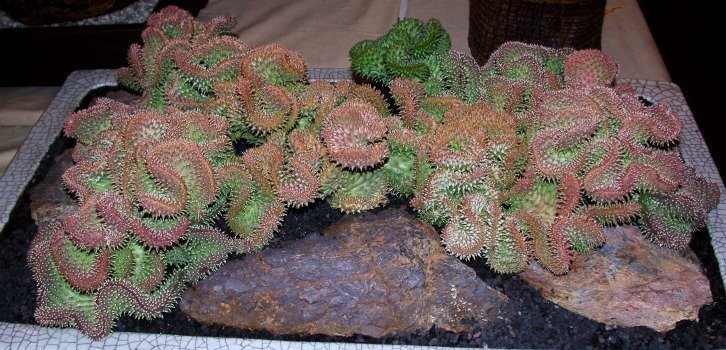
A nice specimen in a plant show (still not as nice as the one I had for a while)
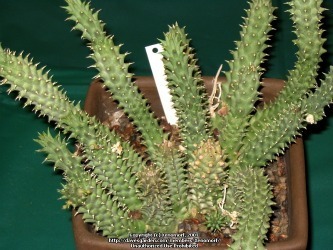
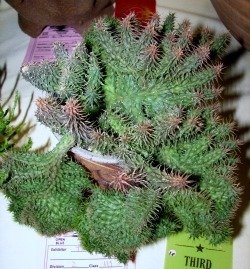
left is a normal Luckhoffia beuneckeri (photo Xenomorf); right is the only other cristate Asclepid I have seen, a Huernia piladdiii
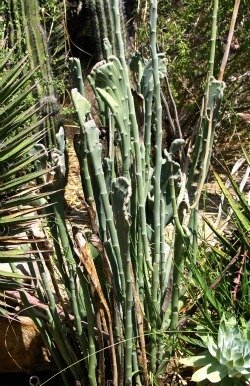
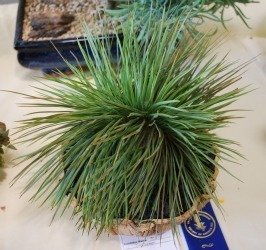
Two last photos: Pedilanthes spontaneously cresting at the Los Angeles Zoo (left) and an unknown Yucca species cresting (and winning) at a show (right)
There are so many more oddities and curiosities out there, but I have already taken up far more space intended for these articles. For more about crests and other monsters see the following links:
http://www.tucson-gardener.com/graphics/Galleries/Crested/Crested.html
http://www.sgvcss.com/communique/cotm_2003_03.pdf
http://www.lapshin.org/cultivar/N21/jorn-e.htm
http://www.cssnz.org/cristate-and-monstrose.php
http://www.bing.com/images/search?q=monstrose+succulents&qpvt=monstrose+succulents&FORM=IGRE#x0y0
Copyright © www.100flowers.win Botanic Garden All Rights Reserved